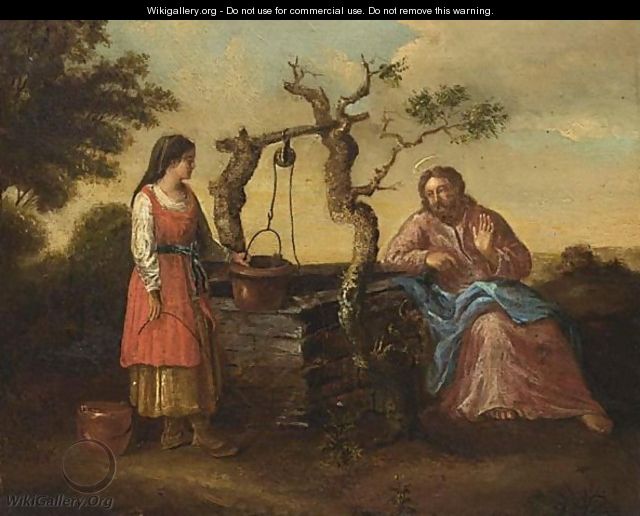Spiritual Sunday
“Healing water” is the focus of today’s liturgical readings, which include Moses finding water in the desert and Jesus encountering “the woman at the well.” Poet Carolyne Wright’s moving poem transforms the Samaritan woman into a composite figure of all women who are searching for the divine within our profane world.
In the Biblical story, Jesus offers the Samaritan woman spiritual water:
Jesus came to a Samaritan city called Sychar, near the plot of ground that Jacob had given to his son Joseph. Jacob’s well was there, and Jesus, tired out by his journey, was sitting by the well. It was about noon.
A Samaritan woman came to draw water, and Jesus said to her, “Give me a drink.” (His disciples had gone to the city to buy food.) The Samaritan woman said to him, “How is it that you, a Jew, ask a drink of me, a woman of Samaria?” (Jews do not share things in common with Samaritans.) Jesus answered her, “If you knew the gift of God, and who it is that is saying to you, ‘Give me a drink,’ you would have asked him, and he would have given you living water.” The woman said to him, “Sir, you have no bucket, and the well is deep. Where do you get that living water? Are you greater than our ancestor Jacob, who gave us the well, and with his sons and his flocks drank from it?” Jesus said to her, “Everyone who drinks of this water will be thirsty again, but those who drink of the water that I will give them will never be thirsty. The water that I will give will become in them a spring of water gushing up to eternal life.” The woman said to him, “Sir, give me this water, so that I may never be thirsty or have to keep coming here to draw water.” (John 4:5-15)
In Wright’s poem, the woman at the well appears to be reflecting upon her “weed-choked” life, into which “brackish water” has been seeping for a long time. (The purifying “rains of bygone eras” are a distant childhood memory.) Yet she senses a deeper truth behind what passes for reality. Jesus points out cracks in that reality, “artesian fault lines,” so that she dreams of “Chaldean fountains, oases of date palms and minarets.” Jacob’s Well holds out the promise of something more.
In her vision she is both the Virgin Mary visited by Gabriel and Jacob witnessing angels ascending and descending. While her surface identity may be Samaritan, to pull aside the veil is to acknowledge a transcendental soul. This is the “second self” that the woman senses as she gazes into the well.
We whose wisdom cuts us off from the divine–Wright calls us “artisans of sorrow”–should be prepared to sit down with this flawed woman, who is thirsty for something more and who is a version of ourselves. Time and again in the gospels, Jesus reveals that God chooses unlikely but very specific vessels (fallen women, tax collectors) to point to the presence of the transcendent within the finite. This is “mystery’s precision.”
Wright informs us that her poem is a “ghazal,” which (to quote Wikipedia) is “a poetic form with rhyming couplets and a refrain, each line sharing the same meter.” The Kashmiri poet Agha Shahid Ali, to whom this poem is dedicated, introduced the ghazal to English audiences.
Ghazal: Woman at the Well
By Carolyne Wright
In this late season, who is the woman at the well
drawing water, reflecting on the woman at the well?
Millennial fissures in the well-rim, weed-choked cracks
where brackish water rises for the woman at the well.
At the bottom of the well shaft, the sky’s reflective eye
opens, closes on the shadow of the woman at the well.
Where are the rains of bygone eras? Preterite weather
yields more rusted bucketsful for the woman at the well.
Ancestral well of Jacob, where a weary traveler rests,
where Jesus asks for water from the woman at the well.
Oh plane trees of Samaria, in whose shade a stranger
speaks of artesian fault lines to the woman at the well!
Chaldean fountains, oases of date palms and minarets—
how they flourish in the dreams of the woman at the well!
Mirages of marble, pomegranate flowers, cedars of Baalbek
shimmer in the sight of the woman at the well.
On the night of destiny, the angel Gabriel descends
and hovers by the footprints of the woman at the well.
Jacob’s ladder leans against the door of heaven—
on the bottom rung, the woman at the well.
Women of Sychar, women of Shechem! Draw aside your veils,
reveal the features of the woman at the well.
Wise ones, why do you weep? Do you fear your fate
tips a mirror toward the woman at the well?
Oh artisan of sorrow, mystery’s precision, sit down
beside your sister, second self, the woman at the well.
In memoriam Agha Shahid Ali
Further thought: The repeated phrase in the second line, a characteristic of many ghazal poems, has the effect of emphasizing the spiritual truth about herself that the woman senses but doesn’t at first own. To better understand the effect, I turn to to Lucille Clifton’s “the light that came to lucille clifton,” which concludes,
but the light insists on itself in the world;
a voice from the nondead past started talking,
she closed her ears and it spelled out in her hand
“you might as well answer the door, my child,
the truth is furiously knocking.”
The repetition in Wright’s poem is the truth knocking. Jesus is a prophet because he alerts the woman to a truth she has always known.
Previously published:


